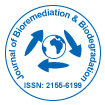Investigating the Electrical Conductivity of Biofilms: Mechanisms, Implications, and Applications
Received Date: Mar 03, 2025 / Accepted Date: Mar 30, 2025 / Published Date: Mar 30, 2025
Abstract
Biofilms are complex microbial communities embedded in an extracellular matrix, which exhibit unique physical and biochemical properties compared to planktonic microorganisms. One such distinctive characteristic is their electrical conductivity, which is of significant interest in both environmental and industrial applications. This review explores the mechanisms underlying biofilm conductivity, including the role of extracellular electron transfer, ion transport, and metabolic processes. We highlight the factors influencing conductivity in biofilms, such as microbial species composition, growth conditions, and environmental factors. Furthermore, the implications of biofilm conductivity in diverse fields, such as wastewater treatment, bioelectrochemical systems, and corrosion, are discussed. Finally, potential future applications, challenges, and opportunities in utilizing biofilm conductivity for sustainable technologies are considered.
Citation: Cholis L (2025) Investigating the Electrical Conductivity of Biofilms:Mechanisms, Implications, and Applications. J Bioremediat Biodegrad, 16: 674.
Copyright: © 2025 Cholis L. This is an open-access article distributed under theterms of the Creative Commons Attribution License, which permits unrestricteduse, distribution, and reproduction in any medium, provided the original author andsource are credited.
Select your language of interest to view the total content in your interested language
Share This Article
Recommended Journals
Open Access Journals
Article Usage
- Total views: 394
- [From(publication date): 0-0 - Dec 19, 2025]
- Breakdown by view type
- HTML page views: 317
- PDF downloads: 77
